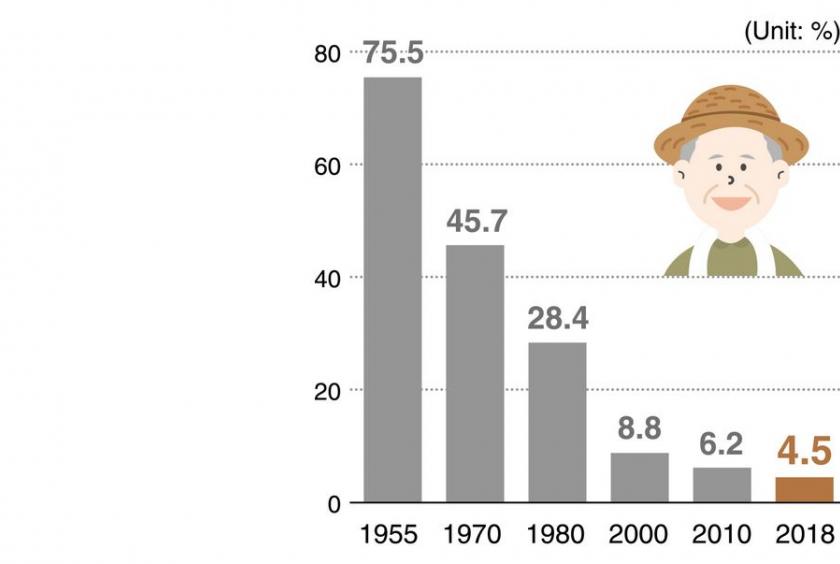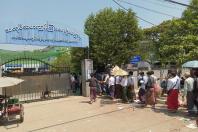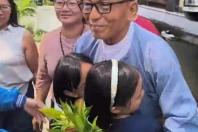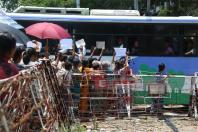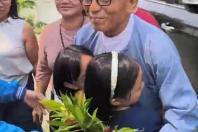SEJONG (Korea Herald/ANN) -- South Korea saw the number and percentage of population engaged in agriculture continue to drop, though the number of urbanites returning or turning to farming has notably increased over the past decade.
According to Statistics Korea, the number of farm population (farming-household population in official) stood at 2.31 million as of 2018, which is a decline by about 750,000 individuals in the 2010s, compared to 3.06 million in 2010.
Further, given 4.03 million recorded in 2000, the nation’s agricultural population has fallen 42.5 percent in less than two decades.
Eighteen years ago, 8.8 percent of the population worked on farms.
But this proportion has continually fallen -- 6.2 percent in 2010, 5.8 percent in 2012, 5.4 percent in 2014, 4.9 percent in 2016 and the all-time low of 4.5 percent in 2018.
By sex, the number of men engaged in the agriculture sector fell from 1.50 million to 1.13 million over the eight years. The number of females declined from 1.56 million to 1.18 million.
By province, South Jeolla Province posted the highest percentage in the farm population with 17.1 percent, trailed by North Gyeongsang with 14 percent, South Chungcheong and Jeju with 12.8 percent, and North Jeolla with 11.4 percent. Gyeonggi Province recorded the lowest of 2.3 percent.
By major city, Sejong topped the list with 4.4 percent as the administrative-oriented city includes a large rural area, followed by Ulsan with 2.5 percent, Gwangju with 1.7 percent, Daegu with 1.6 percent and Daejeon with 1.4 percent. Seoul ranked the bottom with 0.1 percent.
According to other state sources, farming households accounted for 75.5 percent of the population in 1955. But in the wake of industrialization since the 1960s, their portion rapidly decreased -- to 45.7 percent in 1970, 28.4 percent in 1980 and 13.1 percent in 1992.
Experts say the ceaseless drop in the recent decade was attributable to slashed arable lands from housing land development; scrapping the farming business from weak competitiveness; manpower shortage from the fast aging; and steady moving to urban districts.
“Concerns are mounting in terms of difficulty in securing farming production workforce amid the sharply increased percentage of elderly people,” said an official of National Agricultural Cooperative Federation. He expressed worries that the competiveness of the overall farming industry would weaken further.
He said that “it is necessary for (the central and local governments) to map out support programs for the farming households in a bid to promote influxes of young urbanites.”
Participants of the 2018 Farming Experience Tour in Daegu pick the apples at an orchard. The annual event, hosted by the metropolitan city, was aimed at active urban-rural interchanges and promoting the value of agriculture. (Daegu City)
Concerning the drop “despite active returning to farming” among young generations, an official from Statistics Korea claimed those whose farms were below a certain size were not included in the demographic calculation.
He was quoted by a news outlet as saying that “the (demographic) standard for the farm-household population is based on the cultivation on the fields 1,000 square meters or more and the sales records for their products at least worth 1.2 million won ($1,010) per annum.”
His remarks suggest that micro-fields cultivated by only one or two household members is estimated to have taken up a large portion -- exempted from the government agency statistics -- among those returning or turning to rural areas.
In addition, some statistics show that there are many, who engage in service or retail businesses or do not engage in any economic activities after moving to rural districts.
Outbound shipments of Korean farming products, including livestock products, posted $6.6 billion last year. At the same time, imports for the same sector reached $35.2 billion, up 9.4 percent from a year earlier.
The data indicate that exports consistently amount to less than 20 percent of imports. This is a critical trade imbalance, though there are various factors like commerce pacts apart from the farming workforce issue.
Meanwhile, the marked fall in proportion is also seen from those engaged in forestry and fishery, data held by Statistics Korea showed.
The number of people working in the forestry sector was 254,000 in 2010 with their proportion out of the total population reaching 0.5 percent. But their number and percentage fell to 189,000 and 0.4 percent in 2018.
North Gyeongsang Province and South Jeolla Province ranked first and second with 1.7 percent and 1.6 percent, while Gyeonggi Province and Jeju Province marked the lowest and second-lowest with 0.1 percent and 0.2 percent.
The fishery population dropped from 171,000 to 117,000 over the corresponding period. And their proportion also fell by 0.1 percentage point to 0.2 percent as of 2018.
South Jeolla Province held the largest portion, 2.4 percent, trailed by Jeju with 1.4 percent and South Chungcheong with 0.8 percent. Major port cities -- Incheon and Busan -- posted only 0.2 percent and 0.1 percent, respectively.

